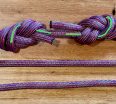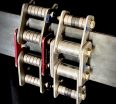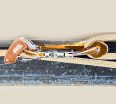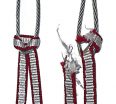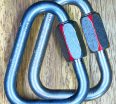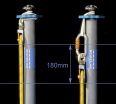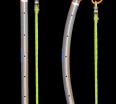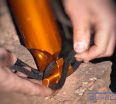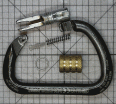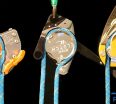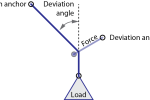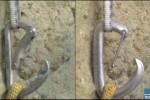Figure-8 Descenders
The Figure-8 descender has been use for over 50 years and most hardware manufacturers have made at least one form of this device. This long history and the simplicity of the device has meant that it does not usually come with instructions. It seems to be assumed that the fundamental design has not changed so published details generally only refer to specific ‘features’ offered by variations to the standard design.
Disclaimer
This discussion is certainly not to be interpreted as instruction. It is simply a presentation of some of the ways that the Figure-8 has been used by others to achieve certain variations in performance. Manufacturers may have instructions that present permitted uses of their products and these must be read, understood, and adhered to prior to and during use.
The techniques presented below will vary significantly according to:
- User experience.
- User weight.
- Rope type, condition, diameter, moisture etc.
- The shape, size, and other attributes of the Figure-8 device.
It is assumed that readers are familiar with the use and function of the Figure-8 descender and that, among other things, there must always be at least one brake-hand firmly in place on the brake strand of rope to manage friction provided by the device. If you are not familiar with the use of this device then do not try these techniques. If you do try any of these then do so in a controlled environment and with an independent safety system to protect you in the event of error or unexpected performance.
Figure-8 Standard Configuration
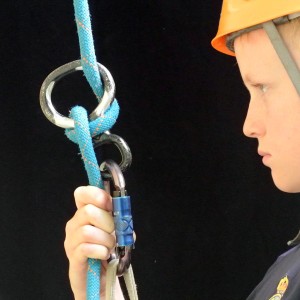
This is the way the Figure-8 is normally used:
- Remove the device from the carabiner.
- Pass a bight of rope through the ‘big’ hole.
- Pull the bight over the small hole and allow it to locate in the shank of the device as the bight is pulled tight.
- Clip the ‘small’ hole of the device back to the carabiner (attached to the belay loop of the harness).
The user can then control their descent by varying the tension held by the hand holding the free/brake rope below the device. Notice that this image shows the user gripping the ‘brake’ rope not just with their main brake hand but also with their second hand immediately below the device and holding this against the spine of the carabiner.
One of the common complaints with the Figure-8 descender is that it is easy to drop as it is free during rope attachment and disconnection. This is even more problematic if a descent finishes in a deep pool of water and the user has to complete the disconnection with hands underwater. A simple solution to this is to have the Figure-8 attached to the carabiner by the ‘big’ hole while approaching the descent. Rather than removing the device, pass the rope through the ‘big’ hole and over the ‘small’ hole, next open the carabiner and finally flip the device so that the ‘small’ hole is clipped to the carabiner. On completion of the descent simply reverse this process and walk away with the Figure-8 ‘at-rest’ clipped to the ‘big’ hole.
Another complaint is that the Figure-8 twists the rope. This twisting varies with brake hand position but it is not normally an issue unless successive pitches are rigged with the same long rope using intermediate rebelays. If this is truly an issue then users can alternate left and right handed device threading to reverse any twists.
Figure-8 Sport Mode
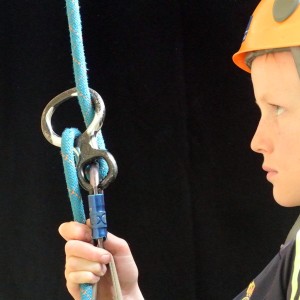
Sport mode gained some early popularity with climbers as a top-rope climbing belay option. Even though there is significantly less friction through the device, ‘lowering-off’ is still manageable because there is extra friction through the connectors at the top of the climb. The reduced friction makes it is easier to ‘take-in’ while the top-belayed climber ascends.
This mode should never be used to belay a lead climber. There is simply not enough frictional assistance provided by the device in the event of a leader fall.
There are times where less friction is desirable during descent especially with very light operators. Those less than 40kg will struggle to feed rope through with the ‘standard configuration’ on all but overhanging descents. Sport mode may be an good option in this case.
Figure-8 Belay Mode
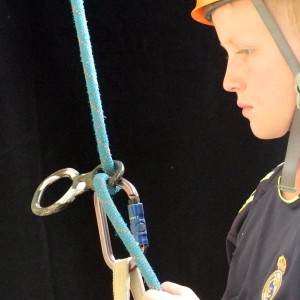
This is the only way a climber should belay another lead-climber with a Figure-8. Used correctly this mode should not only provide sufficient function and friction to catch the leader in the event of a fall but also enable the belayer to ‘pay-out’ rope relatively easily. Lowering or descending in this mode takes practice as the rope does not feed through easily when the device is loaded.
Figure-8 Figure-4-wrap
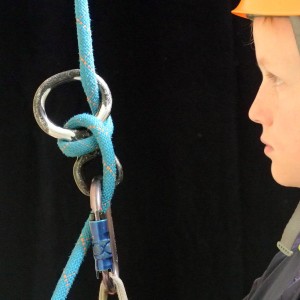
This is the same as the ‘standard configuration’ except for the addition of a final step where that the brake rope is passed through the carabiner. This mode is not commonly used however it provides some additional friction for heavier users. This will help those over 100kg who may otherwise struggle to control their descent on over-hanging pitches with the standard configuration.
Figure-8 Rescue Mode
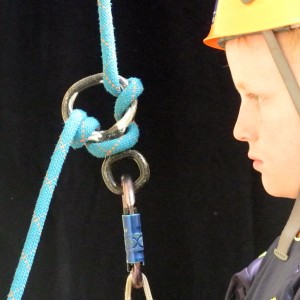
If the rope is passed through the ‘big’ hole a second time then the user has sufficient friction to control very heavy loads. This may be useful in rescue situations where an incapacitated group member is to be accompanied by another experienced operator. This technique, like all others discussed here, must be well understood and practiced in a controlled environment prior to actual use.
Figure-8 Canyon Mode
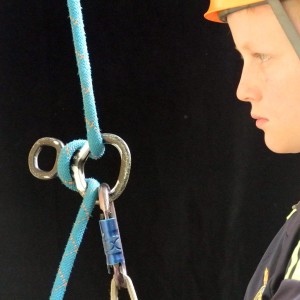
As discussed above, one of the common complaints with the Figure-8 is that it may be difficult to attach/remove in dark/wet/cold environments like canyons. This is certainly an advanced technique but the image shows an option for use that does not require opening of the main carabiner. It is certainly possible that the rope can inadvertently come out of the device if the user stops and unweights the system. The trade-off being considered here is security vs. ease of use. If we want to be able to get the rope out of the device more easily then, of course, the rope may inadvertently come out of the device more easily.
Figure-8 Auto-stop Mode
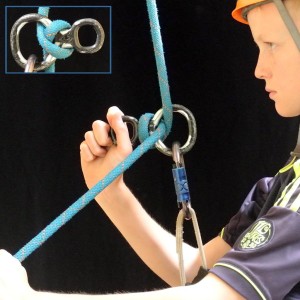
I was shown this method perhaps 20 years ago by a technician from Eastern Europe when discussing the development of Rope Access techniques. When looking at one particular device his response was something like “We can’t afford that where I come from, have you seen this?”. I had not but was immediately impressed with the simplicity.
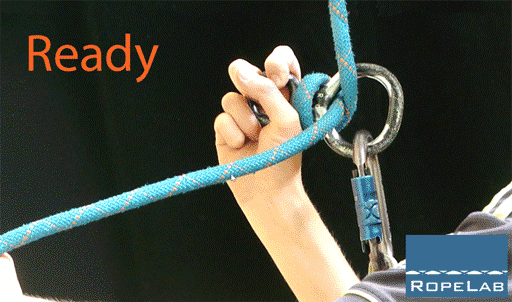
This mode is similar to the canyon mode however there is a deliberate twist in the bight before it is passed over the ‘small’ hole. This twist results in the loaded strand of rope pinching the brake strand against the body of the Figure-8 when unmanaged. Note that there are two possible ways to make this twist and only one results in the correct function. To free this pinch the user must carefully pull down on the ‘small’ hole end of the Figure-8 much like the hand operating the brake lever on many other auto-locking devices.
There are many differences in shape with Figure-8s and each of these will have a very different feel with the auto-stop function. Shorter devices will be harder to unlock as the effective lever is shorter.
This mode, like the canyon mode, is potentially less secure so users may wish to clip a lanyard to the ‘small’ hole to eliminate the likelihood of the twisted loop popping off the ‘small’ hole. Another potential misuse can occur if, once established correctly, the whole system is flipped from, say, right to left-handed operation. If this happens then the system reverts to canyon mode.
Holding Power
We conducted a very simple set of tests on the RopeLab test bed to evaluate the relative holding power of each Figure-8 mode. Tension was applied slowly with an electric winch until rope started to slip through the Figure-8. The ‘One hand’ results are certainly subjective but equate to what I could hold easily with only one had on the brake rope and be comfortable with managing a controlled lower. The ‘Max’ values are what I could hold with two hands grasping firmly before rope would slip through. It is important to note that these values are from single tests with one type off 11mm static rope on a particular Figure-8. I would expect these values to vary significantly with different combinations of rope and device.
| Mode | One hand (kN) | Max (kN) |
| Standard | 0.7 | 2.3 |
| Sport | 0.6 | 1.5 |
| Belay | 1.0 | 1.9 |
| Figure-4 | 1.5 | 3.5 |
| Rescue | 2.0 | 5.9 |
| Canyon | 1.2 | 2.2 |
Summary
The Figure-8 is a versatile piece of equipment and many people have developed specific techniques that extend its effective use far beyond the obvious single person descent device. Its popularity is decreasing as more and more modern specialist devices appear however it hoped that users will always maintain the understanding and skills to use such fundamental ‘building-block’ pieces of equipment.
Thanks to Tom Delaney for his assistance with the images and tests.
Eduardo José Slomp Aguiar has been kind enough to translate this article into Portuguese. We are grateful for his input. The Portuguese translation can be found here.
© Richard Delaney, RopeLab, 2015
Add a Comment
You must be logged in to post a comment.



